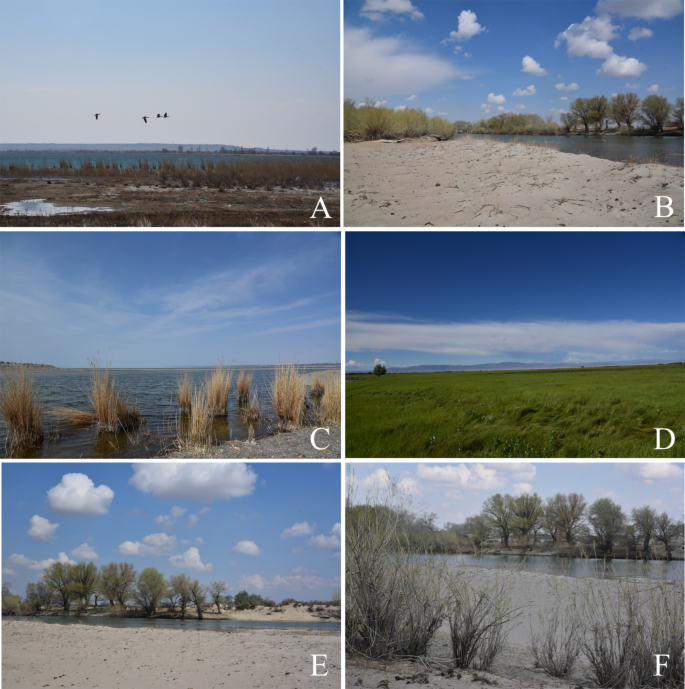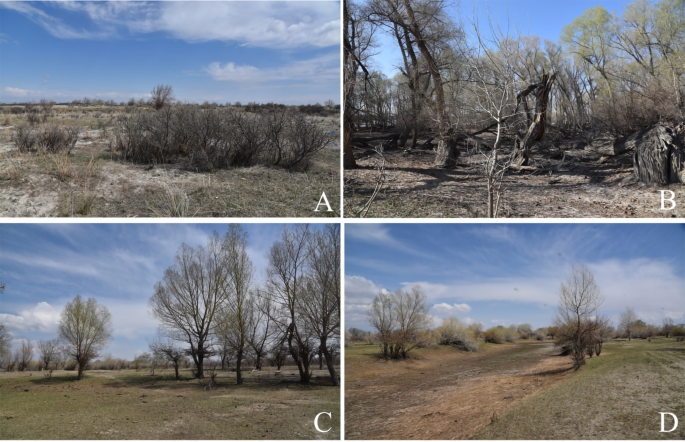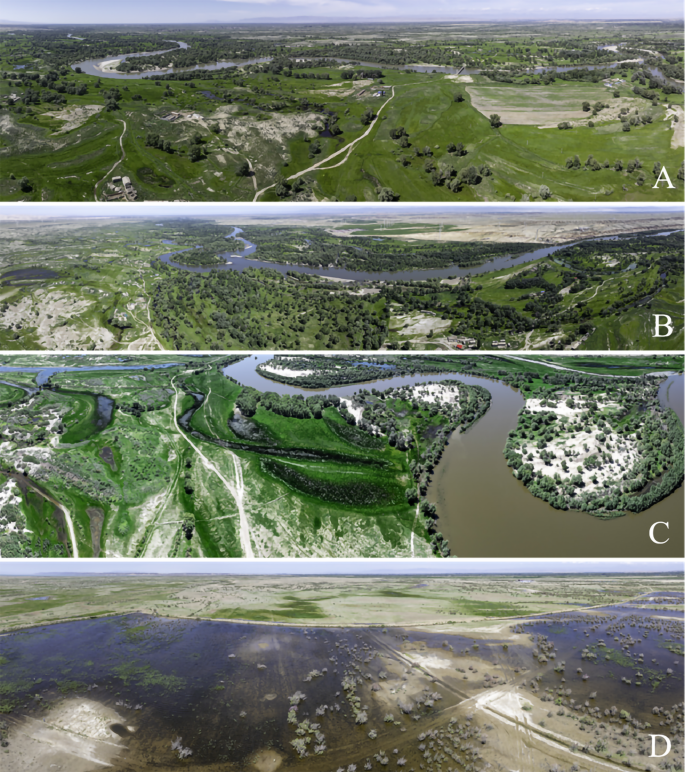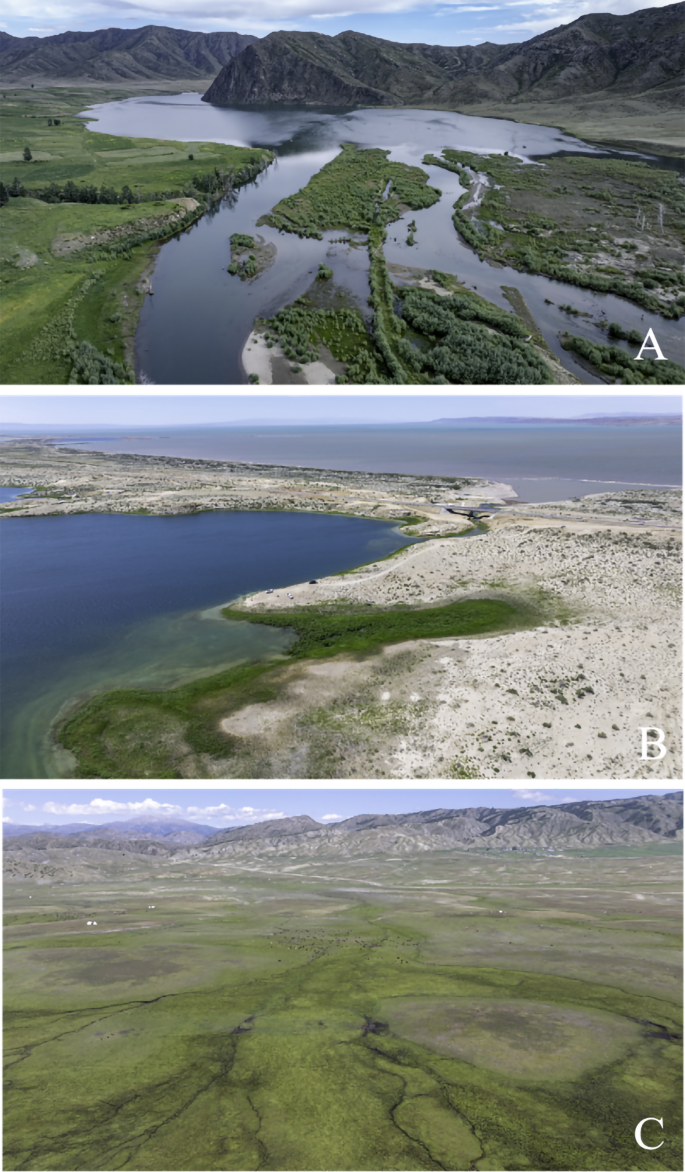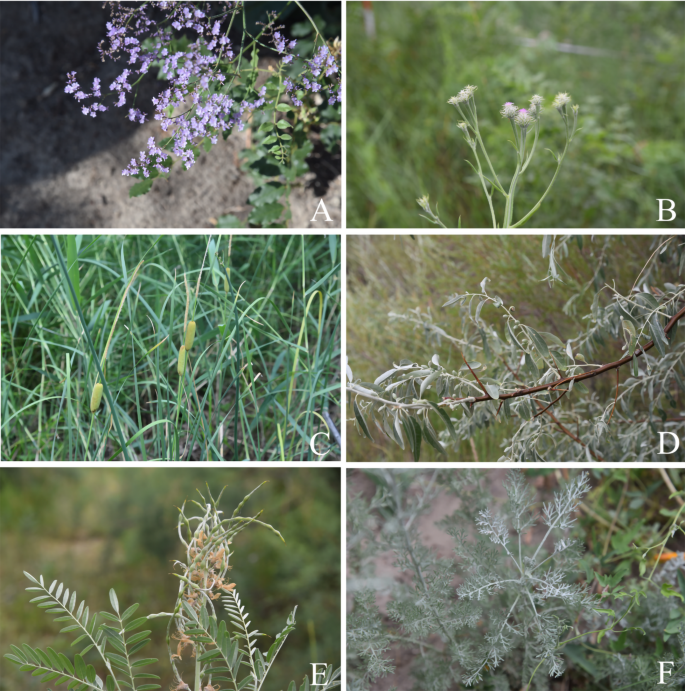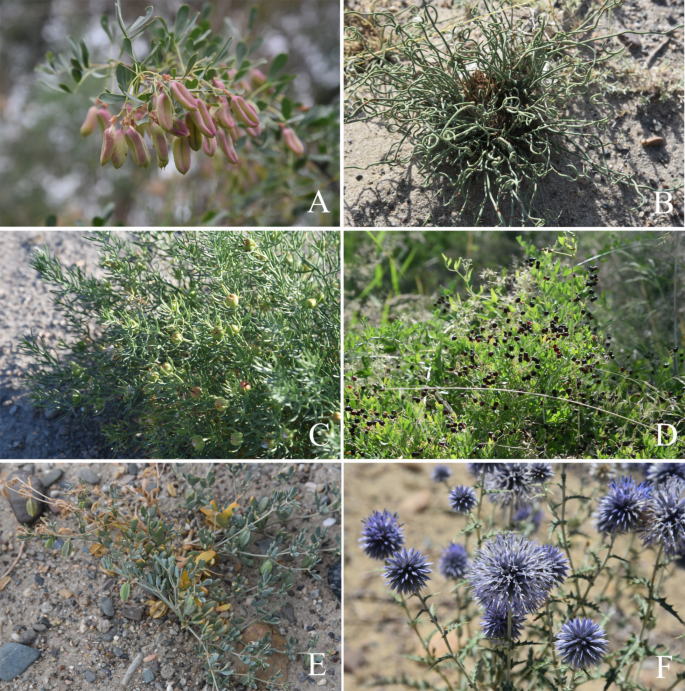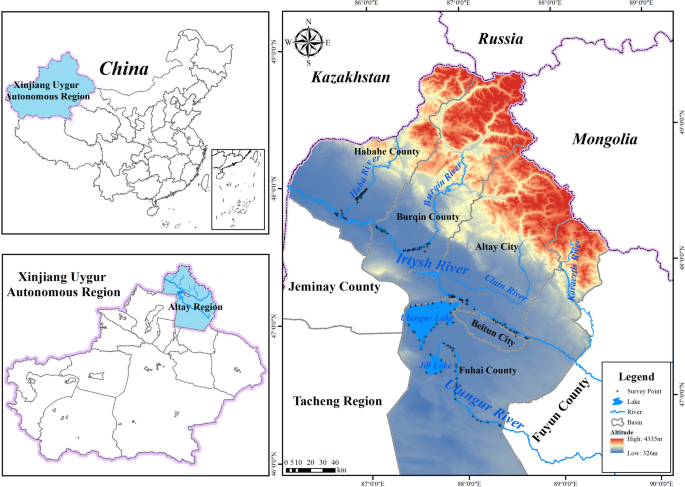[ad_1]
Study site and current vegetation status
The Altay Prefecture is subordinate to the Ili Kazak Autonomous Prefecture in Xinjiang and is located in the northernmost part of Xinjiang (85°31′36″–91°04′23″E, 45°00′00″–49°10′45″N). Altay Prefecture is bordering on Russia, Kazakhstan, and Mongolia, with a total area of 118,000 km2. The terrain is high in the northeast and low in the southwest, with the Irtysh River and the Ulungur River running east-west across the entire region. The climate is characterized by dry and hot summers and severe cold winters, which is a typical continental climate in the cold region of the north temperate zone25. Meteorological data reveal, annual precipitation ranges from 400 to 600 mm in western/northern mountainous areas to 150–200 mm in southeastern plains, and further declining to approximately 95 mm in southern deserts. Mean annual temperature is 3.7 ℃ (with seasonal variations of plus or minus 30 ℃), where plains experience temperatures above 4 ℃ while mountainous areas remain below 4 ℃26.
The distinctive geographic positioning, topography, and climatic conditions of the basin foster a plethora of ecosystems, principally encompassing valley forests and grasslands, as well as the Ulungur Lake ecosystem (Figs. 1, 2, 3 and 4). These ecosystems offer unparalleled ecological, economic, and genetic services27. Due to climate, drainage, and geology, the water quality exhibits a distinct geographical distribution pattern and seasonal changes28,29.
Owing to the sandy soils and the formidable influence of winds, the arid sections of the Irtysh River valley give rise to desert plains characterized by scant vegetation and impoverished soils. The vegetation in the study area is mainly desert meadow and grassland, accounting for 91.58% of the whole vegetated area. The rest are herbaceous swamps distributed in and around the river valley, and broad-leaved forests or shrubs scattered in or near the swamp area (Figs. 5 and 6)30. Among the herbaceous species of the Altay region, Glycyrrhiza inflata Batalin, Phragmites australis (Cav.) Trin. ex Steud., are dominant31.
Some species are from river valleys in the Altay region (Xinjiang, China). A Limonium gmelinii (Willd.) Kuntze (Plumbaginaceae) B Rhaponticum repens (L.) Hidalgo (Asteraceae) C Typha orientalis C.Presl (Typhaceae) D Elaeagnus oxycarpa Schltdl. (Elaeagnaceae) E Sophora alopecuroides L. (Fabaceae) F Artemisia frigida Willd. (Asteraceae). (photographed by Dr. Zhixi Fu).
Some species are from river valleys in the Altay region (Xinjiang, China). A Caragana halodendron (Pall.) Dum.Cours. (Fabaceae) B Peganum harmala L. (Nitrariaceae) C Ephedra przewalskii Stapf (Ephedraceae) D Nitraria sibirica Pall. (Nitrariaceae) E Zygophyllum pterocarpum Bunge (Zygophyllaceae) F Echinops ritro L. (Asteraceae). (Photographed by Dr. Zhixi Fu).
Floristic surveys, specimen collection, and identification
Throughout the period spanning from May 2021 to July 2024, our botanical expedition conducted systematic floristic surveys in the river valleys of the Altay region, focusing on key watersheds including the Ertix River, Burqin River, Ulungur River, and Ulungur Lake (Fig. 7). The surveys were strategically scheduled during peak growing seasons across six sampling campaigns: May 2021, May 2022, July 2022, May 2023, July 2023, and July 2024. Each intensive survey lasted approximately 10–15 days to ensure full spatial and temporal coverage of the study area. A combination of a general walk-over survey method32 and a plotless landscape-defined sampling method for plant specimen collection and sight observation was used to aid the characterization of the flora in the different vegetation types33. The specimens bearing flowers or fruit were collected and identified34 by Prof. Zhixi Fu of the School of Life Sciences, Sichuan Normal University, and were deposited in herbarium 313, Sichuan Normal University Herbarium (SCNU! ) (contact: Associate Prof. Zhixi Fu fuzx2017@sicnu.edu.cn) (see the checklist). Specimens from other collections were identified to species by the herbarium staff. The collection numbers are listed in appendix. Detailed information on identified specimens was recorded. It included habit, habitat, general distribution, and collector details. Species were classified as endemic if their distribution was confined to a specific geographic area, such as exclusively in China or solely in Xinjiang.
We also compiled the checklist from specimens collected and from electronic specimen data collected over the past decades of scientific research. Combined with Flora of China, Atlas of Wild Vascular Plants in Northern Xinjiang, Chinese Virtual Herbarium (CVH, https://www.cvh.ac.cn/), and National Plant Specimen Resource Center (NPSRC, https://www.plantplus.cn/cn) were used to identify the collected specimens. The national conservation status of all the angiosperm plant species collected was assessed using the criteria from the International Union for Conservation of Nature. The Information System of Chinese Rare and Endangered Plants (ISCREP, http://www.iplant.cn/rep/protlist) and IUCN35 were consulted to assess the conservation status of all the species.
An annotated checklist of the vascular plants of the river valleys in the Altay region is presented below. Within this checklist, species are organized alphabetically in each family. Angiosperm classification and nomenclature follow APG IV36 at the family level. For each taxon recorded, full authority is given, growth form, brief notes on habitat and distribution range, voucher specimen number, and the herbarium where it was deposited. The following lists of species include references to the elevation, and where meters are stated, this means meters above sea level. PE refers to the Herbarium, Institute of Botany, Chinese Academy of Sciences, BNU refers to the Herbarium, College of Life Sciences, Beijing Normal University, KUN refers to the Herbarium, Kunming Institute of Botany, Chinese Academy of Sciences, XJBI refers to the Herbarium, Xinjiang Institute of Ecology and Geography, Chinese Academy of Sciences, ISBC refers to the Herbarium, South China Botanical Garden, Chinese Academy of Sciences, WUK refers to the Herbarium, School of Life Sciences, Northwest Agriculture and Forestry University, SCNU refers to the Herbarium, College of Life Sciences, Sichuan Normal University. All acronyms are standardized according to Index Herbariorum (https://sweetgum.nybg.org/science/ih/) [accessed 14 April 2025].
Growth forms of taxa collected were categorized as herbs (plants less than 50 cm high or less than 100 cm, but annual and without persistent woody stems), shrubs (plants between 50 cm and 5 m high with woody stems branching at or near the ground), climbers (plants with twining herbaceous or woody stems) and trees (plants taller than 5 m with a clear main trunk)37,38. Standard bibliographies, for example, Flora of Xinjiang Editorial Committee39were also used to define growth forms, particularly from herbarium specimens. The accuracy of plant taxonomic circumscription and authorities for each taxon was verified using reference material from Flora of China.
[ad_2]
Source link

